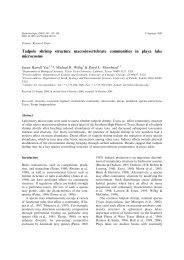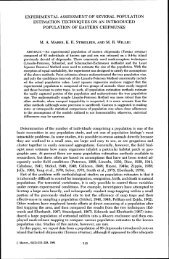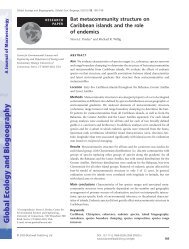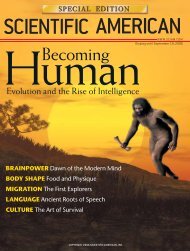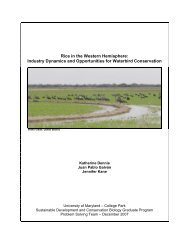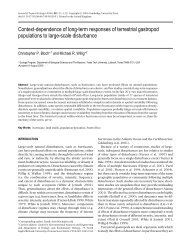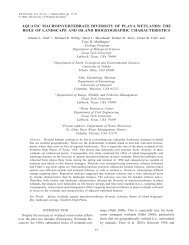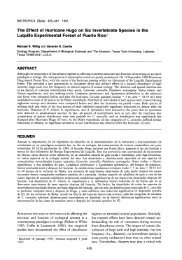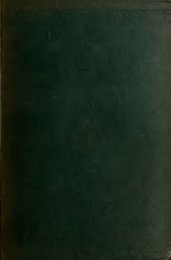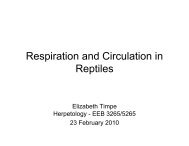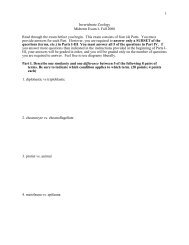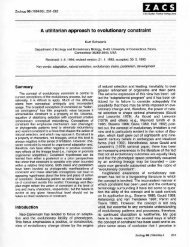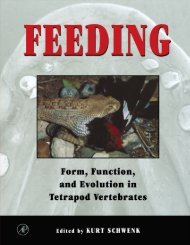Comparative biology and the importance of cladistic classification: a ...
Comparative biology and the importance of cladistic classification: a ...
Comparative biology and the importance of cladistic classification: a ...
Create successful ePaper yourself
Turn your PDF publications into a flip-book with our unique Google optimized e-Paper software.
Biological Journal <strong>of</strong> <strong>the</strong> Linnean Society (1994), 52: 69-82. With 2 figures<br />
<strong>Comparative</strong> <strong>biology</strong> <strong>and</strong> <strong>the</strong> <strong>importance</strong> <strong>of</strong><br />
<strong>cladistic</strong> <strong>classification</strong>: a case study from <strong>the</strong><br />
sensory <strong>biology</strong> <strong>of</strong> squamate reptiles<br />
KURT SCHWENK<br />
Departmenl <strong>of</strong> Ecolou dY Evolutionary Biology, U-43, University <strong>of</strong> Connecticut, Storrs,<br />
CT 06269-3043, U.S.A.<br />
Received 27 April 1993, accepted for publication 23 September 1993<br />
Evolutionary taxonomy has all but succumbed to <strong>cladistic</strong> methodology, but it continues to exert<br />
considerable influence in <strong>the</strong> realm <strong>of</strong> higher <strong>classification</strong>. Some systematists accept <strong>cladistic</strong><br />
methods in phylogeny inference, but allow paraphyly in formal <strong>classification</strong>s. Most important,<br />
however, many traditional <strong>classification</strong>s based on paraphyletic groups (e.g. ‘Reptilia’) remain in<br />
force, deeply entrenched in <strong>the</strong> literature. Cladists have argued that such paraphyletic. <strong>classification</strong>s<br />
can mislead comparative biologists into false evolutionary generalizations, but this assertion has<br />
rarely, if ever, been supported by example. This paper provides a rase study, illustrating in detail<br />
<strong>the</strong> influence <strong>of</strong> a traditional paraphyletic <strong>classification</strong> <strong>of</strong> squamate reptiles on <strong>the</strong> historical<br />
development <strong>of</strong> ideas regarding <strong>the</strong> wolution <strong>of</strong> sensory modes (chemoreception vs. vision) in <strong>the</strong><br />
group. The paraphyletic: <strong>classification</strong> is shown to have led to false generalizations <strong>and</strong> incorrect<br />
conclusions stemming directly from <strong>the</strong> fact that <strong>the</strong> <strong>classification</strong> did not reflect accurately <strong>the</strong><br />
phylogeny <strong>of</strong> Squamata, particularly <strong>the</strong> <strong>cladistic</strong> relationships <strong>of</strong> Gekkota. This study provides<br />
direct evidence that evolutionary generalization must be rootcd in <strong>the</strong> branching pattern <strong>of</strong><br />
phylogeny <strong>and</strong> not <strong>the</strong> potentially arbitrary categorical ranks <strong>of</strong> traditional taxonomies. It fur<strong>the</strong>r<br />
supports recent ralls for a truly phylogenctir taxonomy that has as its philosophical core <strong>the</strong> concept<br />
<strong>of</strong> descent.<br />
ADDITIONAL KEY WORDS:--Reptiha - Squamata -- Evolution -- Systematics - Taxonomy<br />
Cladistics - Paraphyly - Chemoreception.<br />
CONTEN‘IS<br />
Introduction . . . . . . . . . . .<br />
Squamate <strong>classification</strong> <strong>and</strong> phylogeny: background .<br />
Squamate chemoreception: background . . , .<br />
Classification <strong>and</strong> chemoreception . , . , ,<br />
A conflation <strong>and</strong> its consequences , . . ,<br />
Confusion . . . . . . . . . .<br />
Resolution . . . . . . . . . .<br />
Conclusions . . . . . . . . . .<br />
Acknowledgements . . . . . . . . .<br />
References . . . . . . . . . . .<br />
. . . . . . . . 70<br />
. . . . . . . . 72<br />
. . . . . . . . 74<br />
. . . . . . . . 75<br />
. . . . . . . . 75<br />
. . . . . . . . 77<br />
. . . . . . . . 78<br />
. . . . . . . . 79<br />
. . . . . . . . no<br />
. . . . . . . . 81<br />
... a good <strong>classification</strong>, like a <strong>the</strong>ory, permits one to make ‘predictions’. [Mayr <strong>and</strong><br />
Ashlock, 1991: 1251<br />
Camp’s major division <strong>of</strong> <strong>the</strong> Sauria has thus passed one <strong>of</strong> <strong>the</strong> tests <strong>of</strong> <strong>classification</strong>-<br />
it has proven to have predictive value. [Underwood, 1971: ix]<br />
0024-4066/94/050069 + 14 $08.00/0<br />
69<br />
0 1994 The Linnean Society <strong>of</strong> London
70 K. SCHWENK<br />
It is obvious that groups held to be equal or dichotomous on <strong>the</strong> basis <strong>of</strong> <strong>classification</strong><br />
may not have had an equal extent <strong>of</strong> geologic history, <strong>and</strong> when it is intended to<br />
illustrate this history simultaneously with <strong>the</strong> <strong>classification</strong> some difficulties present<br />
<strong>the</strong>mselves. [Camp, 1923: 3361.<br />
INTRODUCTION<br />
Systematic <strong>biology</strong>, in its narrow sense, has three overlapping charges: <strong>the</strong><br />
naming <strong>of</strong> species, <strong>the</strong>ir <strong>classification</strong>, <strong>and</strong> <strong>the</strong> reconstruction <strong>of</strong> <strong>the</strong>ir<br />
phylogenies. The first <strong>of</strong> <strong>the</strong>se pursuits is little changed since Linnaeus, but <strong>the</strong><br />
manner in which <strong>the</strong> latter two are undertaken depends on <strong>the</strong> school <strong>of</strong> thought<br />
to which an investigator adheres: phenetics, evolutionary taxonomy or <strong>cladistic</strong>s<br />
(e.g. Wiley, 1981; Ridley, 1986; Mayr & Ashlock, 1991). These have been<br />
admirably reviewed by <strong>the</strong>se authors <strong>and</strong> o<strong>the</strong>rs, <strong>and</strong> it is not <strong>the</strong> purpose <strong>of</strong> this<br />
paper to discuss <strong>the</strong>ir various merits <strong>and</strong> deficiencies. Ra<strong>the</strong>r, I focus on,<br />
perhaps, <strong>the</strong> most contentious aspect <strong>of</strong> <strong>the</strong> controversy, namely criteria on<br />
which we base organismal <strong>classification</strong>s in light <strong>of</strong> recovered phylogenies.<br />
Purely phenetic <strong>classification</strong> has fallen into ill favour among most systematists<br />
owing largely to its failure to differentiate among similarity stemming from<br />
convergence, similarity stemming from retention <strong>of</strong> ancestral attributes, <strong>and</strong><br />
similarity stemming from shared evolutionary novelty uniquely evolved in a<br />
common ancester (homoplasy, symplesiomorphy <strong>and</strong> synapomorphy,<br />
respectively, in <strong>cladistic</strong> parlance). Arguably, <strong>the</strong> greatest contribution <strong>of</strong><br />
<strong>cladistic</strong>s is its recognition that phylogeny can only be inferred from<br />
synapomorphy (e.g. Wiley el al., 1991). Early evolutionary taxonomists used a<br />
more informal method <strong>of</strong> phylogeny reconstruction that did not explicitly<br />
exclude symplesiomorphy (e.g. Simpson, 1945) ; however, recent workers have<br />
accepted <strong>the</strong> central role <strong>of</strong> synapomorphy in phylogenetic inference (e.g. Mayr,<br />
198 1). Therefore, in <strong>the</strong>ir current incarnations, <strong>the</strong> schools <strong>of</strong> evolutionary<br />
taxonomy <strong>and</strong> <strong>cladistic</strong>s (sensu Hennig, 1966) differ little or not at all in <strong>the</strong> way<br />
in which species are named <strong>and</strong> phylogenies reconstructed. However, when<br />
constructing a <strong>classification</strong> based on a phylogeny so-inferred, <strong>the</strong>y may be at<br />
odds in <strong>the</strong>ir choice <strong>of</strong> criteria on which to base supraspecific taxa.<br />
Cladists argue that <strong>classification</strong>s <strong>and</strong> named taxa should reflect evolutionary<br />
entities <strong>and</strong> <strong>the</strong>refore rely only on <strong>the</strong> branching pattern <strong>of</strong> <strong>the</strong> phylogeny. Every<br />
named taxon will, <strong>the</strong>refore, be monophyletic. All o<strong>the</strong>r aspects <strong>of</strong> phenotypic<br />
evolution, such as rate <strong>and</strong> degree <strong>of</strong> divergence from a common ancestor, while<br />
interesting, are <strong>of</strong> secondary <strong>importance</strong> (Ridley, 1986). This convention allows<br />
any investigator to extract accurate information about a phylogeny from <strong>the</strong><br />
<strong>classification</strong>. In contrast, evolutionary taxonomists such as Mayr ( 1974, 1981)<br />
<strong>and</strong> Mayr & Ashlock (1991) believe that a <strong>classification</strong> should contain<br />
information in addition to <strong>the</strong> branching pattern <strong>of</strong> phylogeny. They might<br />
emphasize some aspect <strong>of</strong> phenotypic evolution, usually <strong>the</strong> relative degree <strong>of</strong><br />
morphological divergence among lineages, by formally recognizing a<br />
paraphyletic taxon (a lineage containing an ancestor <strong>and</strong> some, but not all <strong>of</strong> its<br />
descendants). The classic example <strong>of</strong> this practice <strong>and</strong> its difference from<br />
<strong>cladistic</strong> <strong>classification</strong> is <strong>the</strong> treatment <strong>of</strong> birds <strong>and</strong> reptiles (Fig. 1). The<br />
evolutionary taxonomist’s notion <strong>of</strong> a reptile excludes birds because birds, have,<br />
in <strong>the</strong>ir view, diverged so radically from conventional reptiles (e.g. <strong>the</strong>y have
CLADISTIC CLASSIFICATION<br />
A Reptilia Aves<br />
B Reptilia<br />
Figure I. The phylogeny <strong>of</strong> living reptiles <strong>and</strong> a classic example <strong>of</strong> evolutionary versus <strong>cladistic</strong><br />
<strong>classification</strong>. (A) an evolutionary-taxonomic <strong>classification</strong>; (B) a <strong>cladistic</strong> <strong>classification</strong>. Note that<br />
<strong>the</strong> evolutionary <strong>classification</strong> assumes that <strong>the</strong> ancestors <strong>of</strong> birds were reptiles, but <strong>the</strong> prerise point<br />
along <strong>the</strong> clade where this transformation occurred is unspecified. The situation is actually morc<br />
confusing than shown, because if <strong>the</strong> next outgroup, Synapsida/Mammalia, were illustrated, <strong>the</strong><br />
polygon enclosing <strong>the</strong> paraphyletic ‘Reptilia’ would become more complex, including <strong>the</strong> base <strong>of</strong> <strong>the</strong><br />
mammal stem (Synapsida, considered to be reptiles) but not its terminal end (Mamrnaliaj.<br />
fea<strong>the</strong>rs, <strong>the</strong>y fly, <strong>the</strong>y are endo<strong>the</strong>rmic, etc.) with which <strong>the</strong>y share a common<br />
ancestor. The formal taxon Reptilia in such a scheme is paraphyletic because it<br />
excludes one descendant lineage, <strong>the</strong> birds. Birds are accorded <strong>the</strong>ir own taxon<br />
(Aves) <strong>of</strong> equal rank as Reptilia. The <strong>cladistic</strong> taxon Reptilia must include birds<br />
because <strong>the</strong>y share a common ancestor with all <strong>the</strong> o<strong>the</strong>r, traditionally named<br />
reptilian taxa. Hence birds are regarded as a specialized subset <strong>of</strong> reptiles <strong>and</strong><br />
are named as such (e.g. Rowe, 1986). The potential problem explored in this<br />
paper is that, to a naive investigator, lizards <strong>and</strong> crocodilians must appear more<br />
closely related than ei<strong>the</strong>r is to birds. Can this false notion mislead his or her<br />
evolutionary conclusions?<br />
71
72 K. SCHWENK<br />
Classifications, like language, not only reflect our thought, but direct <strong>and</strong><br />
constrain it (Harvey <strong>and</strong> Pagel, 1991; Woese, K<strong>and</strong>ler & Wheelis, 1991). The<br />
reason for this is simply that many comparative biologists reb on classijications <strong>and</strong> not<br />
phylogenies to shape <strong>the</strong>ir evolutionary <strong>and</strong> functional generalizations. Can a<br />
non-<strong>cladistic</strong> <strong>classification</strong>, in fact, misdirect biological generalization? In this<br />
paper I document one such case taken from <strong>the</strong> literature on <strong>the</strong> sensory <strong>biology</strong><br />
<strong>of</strong> squamate reptiles (lizards, snakes <strong>and</strong> <strong>the</strong>ir allies). I show that a traditional,<br />
evolutionary-taxonomic (paraphyletic) <strong>classification</strong> <strong>of</strong> squamate reptiles has<br />
resulted in false generalizations regarding <strong>the</strong> sensory <strong>biology</strong> <strong>of</strong> <strong>the</strong> group; in<br />
particular it has contributed to <strong>the</strong> mischaracterization <strong>of</strong> one speciose lineage,<br />
<strong>the</strong> Gekkota, despite <strong>the</strong> existence <strong>of</strong> contradictory evidence.<br />
This case study serves two purposes: first, it provides systematists with a<br />
concrete example illustrating <strong>the</strong> pitfalls <strong>of</strong> non-<strong>cladistic</strong> <strong>classification</strong>, pitfalls<br />
feared <strong>and</strong> alluded to by proponents <strong>of</strong> cladism (e.g. Harvey & Pagel, 1991; 52),<br />
but rarely, if ever, documented. Second, it provides a cautionary tale to all<br />
comparative biologists, pointing to <strong>the</strong> need to use phylogenies <strong>and</strong> not<br />
<strong>classification</strong>s in evolutionary analyses, <strong>and</strong> to reconsider resistance to <strong>cladistic</strong><br />
revisions <strong>of</strong> traditional taxonomies.<br />
SQUAMATE CLASSIFICATION AND PHYLOGENY: BACKGROUND<br />
In 1923 Camp published his classic monograph on <strong>the</strong> relationships <strong>of</strong> <strong>the</strong><br />
lizards. This study has remained <strong>the</strong> basis for our underst<strong>and</strong>ing <strong>of</strong> squamate<br />
relationships until very recently. Camp was a product <strong>of</strong> his time, so it is not<br />
surprising that his <strong>classification</strong> is in conflict with <strong>the</strong> <strong>cladistic</strong> relationships<br />
expressed in his own published phylogeny (Fig. 2A). He divided squamates into<br />
two ‘Divisions,’ <strong>the</strong> Ascalabota <strong>and</strong> <strong>the</strong> Autarchoglossa. His Ascalabota<br />
contained <strong>the</strong> clades Iguania <strong>and</strong> Gekkota (<strong>the</strong> latter containing, at <strong>the</strong> time,<br />
only <strong>the</strong> single family Gekkonidae). In so doing, Camp (1923) was fully aware<br />
that gekkotans were more closely related to Autarchoglossans than to Iguanians<br />
<strong>and</strong> that Ascalabota represented, in modern terminology, a paraphyletic group.<br />
He chose to emphasize in his <strong>classification</strong> <strong>the</strong> retention by both iguanians <strong>and</strong><br />
gekkotans <strong>of</strong> certain primitive morphological states.<br />
Using a larger data set <strong>and</strong> <strong>cladistic</strong> methodology, Estes, de Queiroz &<br />
Gauthier, ( 1988) re-examined squamate relationships. Remarkably, <strong>the</strong>ir<br />
phylogeny does not differ substantively from that <strong>of</strong> Camp (1923) (Fig. 2). In<br />
<strong>the</strong>ir <strong>cladistic</strong> <strong>classification</strong>, Estes et al. (1988) abolished Ascalabota as a formal<br />
taxon, recognizing <strong>the</strong> sister relationship between Gekkota <strong>and</strong> Camp’s<br />
Autarchoglossa, <strong>and</strong> referred to this inclusive clade as ‘Scleroglossa’ (Fig. 2b).<br />
Their <strong>classification</strong> reflects <strong>the</strong> basal dichotomy between <strong>the</strong> clade Iguania <strong>and</strong><br />
<strong>the</strong> remaining squamates, <strong>the</strong> Scleroglossa.<br />
Kluge (1989) reanalysed Estes et al.’s (1988) data <strong>and</strong> found that <strong>the</strong>re is more<br />
ambiguity in relationships among some scleroglossan taxa than originally<br />
suggested, but he confirmed <strong>the</strong> Iguania-Scleroglossa dichotomy. This<br />
dichotomy was also independently corroborated by Schwenk (1988). There is<br />
some evidence that two <strong>of</strong> <strong>the</strong> three nominal ‘families’ <strong>of</strong> Iguania are <strong>the</strong>mselves<br />
paraphyletic (Frost & E<strong>the</strong>ridge, 1989), but <strong>the</strong> evidence is equivocal <strong>and</strong> is not<br />
relevant to <strong>the</strong> ensuing discussion. For clarity <strong>the</strong>se taxa (Iguanidae <strong>and</strong><br />
Agamidae) are treated here as if monophyletic.
Ascalabota<br />
Iguania<br />
CLADISTIC CLASSIFICATION 73<br />
Autarchoglossa<br />
Scleroglossa<br />
Figure 2. (A) Camp’s (1923) phylogeny <strong>of</strong> squamate reptiles <strong>and</strong> his evolutionary <strong>classification</strong> <strong>of</strong><br />
same. Note that Ascalabota is paraphyletic, containing <strong>the</strong> Gekkonidae, sister group <strong>of</strong> <strong>the</strong><br />
Autarchoglossa. Zonuridae = Cordylidae; (B) Estes, de Queiroz & Gauthier’s ( 1988) <strong>cladistic</strong><br />
phylogeny <strong>and</strong> <strong>classification</strong>. The taxon Scleroglossa is monophyletic, including Gekkota plus<br />
Autarchoglossa. Note that <strong>the</strong> taxa are defined on <strong>the</strong> basis <strong>of</strong> lineages, a common ancestor <strong>and</strong> its<br />
descendents, thus obviating <strong>the</strong> confusion caused by an anagenic transition from one form to<br />
ano<strong>the</strong>r (e.g. ‘reptile’ to bird, or ‘reptile’ to mammal).<br />
Finally, I note, because it becomes significant in <strong>the</strong> discussion below, that<br />
Camp (1923) made two undoubted errors in his taxonomic assignments:<br />
inclusion <strong>of</strong> <strong>the</strong> Pygopodidae <strong>and</strong> Zonuridae (Cordylidae) in <strong>the</strong> Anguimorpha<br />
(Fig. 2A). These taxa are now established unequivocally as <strong>the</strong> sister taxa <strong>of</strong>
74 K. SCHWENK<br />
Gekkonidae <strong>and</strong> Scincidae, respectively (e.g. Estes et al., 1988 <strong>and</strong> references<br />
<strong>the</strong>rein), Indeed, pygopodids may be derived from within Gekkonidae (Kluge,<br />
1987). Salient here is <strong>the</strong> recognition that change in <strong>the</strong> placement <strong>of</strong> <strong>the</strong><br />
Pygopodidae resulted in its transfer from Camp's (1923) Autarchoglossa to his<br />
Ascalabota.<br />
Until publication <strong>of</strong> <strong>the</strong> Estes et al. (1988) phylogeny <strong>and</strong> <strong>classification</strong>, <strong>and</strong><br />
for a year ot two after, nearly all workers in squamate sensory <strong>biology</strong> turned to<br />
Camp ( 1923) for evolutionary interpretations <strong>of</strong> <strong>the</strong>ir work. Unfortunately,<br />
virtually all such workers (cited below) referred not to Camp's (1923)<br />
phylogeny, but to his <strong>classification</strong>, specifically to his dichotomous division <strong>of</strong> <strong>the</strong><br />
group into Ascalabota <strong>and</strong> Autarchoglossa. These investigators failed to make<br />
<strong>the</strong> distinction between <strong>classification</strong> <strong>and</strong> phylogeny <strong>and</strong> ei<strong>the</strong>r did not realize<br />
<strong>the</strong> paraphyletic nature <strong>of</strong> Ascalabota or did not recognize its significance to <strong>the</strong><br />
interpretation <strong>of</strong> <strong>the</strong>ir results. Below I discuss examples <strong>of</strong> this work, emphasizing<br />
development <strong>of</strong> ideas regarding <strong>the</strong> evolution <strong>of</strong> sensory modalities among<br />
squamates, in particular chemoreception <strong>and</strong> <strong>the</strong> <strong>biology</strong> <strong>of</strong> gekkotans.<br />
SQUAMATE CHEMORECE1"I'ION: BACKGROUND<br />
The chemical senses <strong>of</strong> squamate reptiles have been ably reviewed elsewhere<br />
(e.g. Burghardt, 1980; Simon, 1983; Halpern, 1992). It is sufficient to note here<br />
that most squamates have recourse to at least three different chemosensory<br />
systems: gustation, olfaction <strong>and</strong> vomerolfaction. Gustation is <strong>the</strong> sense <strong>of</strong> taste, a<br />
plesiomorphic attribute <strong>of</strong> vertebrates <strong>and</strong> one for which little information is<br />
available for squamates (Schwenk, 1985, 199313). A growing body <strong>of</strong><br />
circumstantial evidence suggests, however, that its primary role is in determining<br />
palatability <strong>of</strong> food once it is held within <strong>the</strong> mouth. As such, gustation might<br />
mediate learned behaviour related to food preference (e.g. Burghardt, Wilcoxon<br />
& Czaplicki, 1973; Schwenk, 1985, 1986, 1993b). Olfaction <strong>and</strong> vomerolfaction<br />
represent <strong>the</strong> chemical senses <strong>of</strong> <strong>the</strong> nasal capsule, <strong>and</strong> refer to stimulation <strong>of</strong> <strong>the</strong><br />
sensory epi<strong>the</strong>lia <strong>of</strong> <strong>the</strong> nasal chamber sensu strict0 <strong>and</strong> <strong>the</strong> vomeronasal<br />
uacobson's) organs, respectively. Olfaction, like gustation, has received little<br />
attention in squamate <strong>biology</strong> (Schwenk, 1993a) <strong>and</strong> is, <strong>the</strong>refore, difficult to<br />
evaluate functionally <strong>and</strong> phylogenetically. Vomerolfaction, however, has been<br />
<strong>the</strong> subject <strong>of</strong> extensive experimental <strong>and</strong> behavioural investigation (see<br />
Halpern, 1992). It is highly developed in many squamates, as in many<br />
mammals, <strong>and</strong> is associated, in squamates, with a unique form <strong>of</strong> chemical<br />
sampling, tongue-flicking. During chemosensory exploration, <strong>the</strong> tongue is<br />
protruded from <strong>the</strong> mouth <strong>and</strong> in some species, oscillated (e.g. Gove, 1979). It<br />
usually contacts ano<strong>the</strong>r individual, an object, or <strong>the</strong> substrate, but it might not.<br />
The mechanism by which molecules so-retrieved are delivered to <strong>the</strong><br />
vomeronasal organs is not yet fully understood (e.g. Halpern, 1992; Young,<br />
1993).<br />
Vomeronasal <strong>and</strong> nasal olfactory sensory cells project, respectively, to <strong>the</strong><br />
accessory <strong>and</strong> main olfactory bulbs <strong>of</strong> <strong>the</strong> telencephalon. Their pathways remain<br />
almost entirely distinct throughout <strong>the</strong> brain (Lohman & Smeets, 1993). This<br />
anatomical segregation is reflected in functional partitioning <strong>of</strong> <strong>the</strong> two systems:<br />
(1) nasal olfaction is a more general sense sensitive to volatile chemicals <strong>and</strong><br />
operating over large distances. It is implicated in food <strong>and</strong> predator detection in
CLADISTIC CLASSIFICATION 75<br />
some species (Schwenk, 1993a), but it may be most important as a general<br />
exploratory sense that, along with vision, triggers tongue-flicking <strong>and</strong><br />
vomerolfaction (e.g. Cowles & Phelan, 1958; Duvall, 198 1 ; Halpern, 1992;<br />
Graves, 1993); (2) vomerolfaction seems most important in sensing more<br />
proximate <strong>and</strong> circumscribed chemical sources <strong>of</strong> lower volatility. It is clearly<br />
important in species <strong>and</strong> sex discrimination, sexual behaviour, <strong>and</strong> investigation<br />
<strong>of</strong> novel stimuli, in general. Vomerolfaction may have additional functions,<br />
particularly in snakes (e.g. Burghardt, 1970, 1980; Simon, 1983; Halpern, 1992).<br />
CLASSIFICATION AND CHEMORECEPTION<br />
A conjution <strong>and</strong> its consequences<br />
The <strong>cladistic</strong> <strong>classification</strong> <strong>of</strong> Squamata reflects a nested hierarchy <strong>of</strong> taxa in<br />
contrast to Camp’s ( 1923) fundamental dichotomy. As currently conceived, <strong>the</strong><br />
sensory <strong>biology</strong> <strong>of</strong> squamates is more accurately represented by <strong>the</strong> former than<br />
<strong>the</strong> latter. As such, <strong>the</strong>re is no obvious dichotomy in sensory modes, only lineage-<br />
specific combinations <strong>of</strong> traits expressing a continuum, <strong>of</strong> sorts (Schwenk,<br />
1993b). It is now clear that <strong>the</strong> gekkotans (Gekkonidae <strong>and</strong> Pygopodidae) are<br />
highly chemosensory <strong>and</strong> in most details are more similar to <strong>the</strong>ir fellow<br />
scleroglossans than <strong>the</strong>y are to iguanians (Schwenk, 1993a, b). It is particularly<br />
this relationship, <strong>cladistic</strong> <strong>and</strong> biological, that is misrepresented by Camp’s<br />
( 1923) association <strong>of</strong> gekkotans with iguanians in an inclusive, paraphyletic<br />
taxon, Ascalabota. And it is this misrepresentation, I argue below, that has<br />
particularly misled comparative biologists who have followed Camp’s<br />
<strong>classification</strong>.<br />
Although <strong>the</strong> basis for Camp’s (1923) division <strong>of</strong> squamates into Ascalabota<br />
<strong>and</strong> Autarchoglossa was anatomical, he recognized some correlates. The<br />
principal dichotomy noted by Camp was <strong>the</strong> presence among autarchoglossans<br />
<strong>of</strong> many limbless forms <strong>and</strong> <strong>the</strong> absence <strong>of</strong> such forms among ascalabotans. He<br />
believed that limblessness in <strong>the</strong> Autarchoglossa was ‘permitted’ by <strong>the</strong> presence<br />
<strong>of</strong> a particular abdominal muscle <strong>and</strong> that <strong>the</strong> absence <strong>of</strong> this muscle in <strong>the</strong><br />
Ascalabota precluded limblessness as a viable evolutionary strategy. According<br />
to Camp, <strong>the</strong> ascalabotan condition arose as a result <strong>of</strong> arboreal <strong>and</strong> climbing<br />
specialization with concomitant reduction <strong>of</strong> axial locomotory musculature.<br />
Thus we see in Camp (1923: 385) <strong>the</strong> first expression <strong>of</strong> a biological dichotomy<br />
based on his own paraphyletic <strong>classification</strong>: ascalabotans as largely arboreal, or<br />
at least, climbing lizards <strong>and</strong> autarchoglossans as terrestrial lizards tending<br />
toward “worm-like burrowing, or a limbless, snake-like, grass-living habitus.”<br />
Camp (1923) made no reference to chemoreception, although he has been<br />
incorrectly attributed with this connection (e.g. Simon, 1983). He believed, like<br />
most o<strong>the</strong>rs at <strong>the</strong> time, that tongue-flicking was a tactile, not a chemosensory,<br />
behaviour (see Camp, 1923: 374).<br />
Twenty-five years later, Pratt (1948) published a comparative study <strong>of</strong> <strong>the</strong><br />
lizard nasal capsule <strong>and</strong> <strong>the</strong> relative development <strong>of</strong> <strong>the</strong> olfactory <strong>and</strong><br />
vomeronasal organs. He made no reference to Camp’s (1923) <strong>classification</strong>,<br />
focusing instead on <strong>the</strong> relationship between nasal capsule form (i.e.<br />
chemosensory development) <strong>and</strong> habitat. Pratt (1948: 183) suggested that <strong>the</strong>re is<br />
a trade-<strong>of</strong>f between ‘eye specialization’ <strong>and</strong> development <strong>of</strong> <strong>the</strong> olfactory
76 K. SCHWENK<br />
chamber owing to space limitation in <strong>the</strong> head, erroneously believing that an<br />
increase in visual ability must be linked to an increase in eye size. He <strong>the</strong>n went<br />
on to discuss <strong>the</strong> relationship between habitat <strong>and</strong> vomeronasal development<br />
(p. 184):<br />
Jacobson’s organ is a specialized part <strong>of</strong> <strong>the</strong> olfactory apparatus associated with a<br />
ground living-existence. . . . The degree <strong>of</strong> specialization varies within <strong>the</strong> lizards <strong>and</strong><br />
can be classified according to <strong>the</strong> functioning mechanisms.. . . In arboreal forms <strong>the</strong><br />
organ loses its <strong>importance</strong> in <strong>the</strong> life <strong>of</strong> <strong>the</strong> lizards, <strong>and</strong> as a consequence becomes very<br />
reduced-as in some agamids, non-sensory-as in Anolis, or completely absent-as in<br />
chameleons. . . . Scansorial lizards have a Jacobson’s organ whose development is<br />
intermediate between <strong>the</strong> conditions in terrestrial <strong>and</strong> arboreal lizards.<br />
Thus we see in Pratt (1948) <strong>the</strong> establishment <strong>of</strong> two generalizations: (1) <strong>the</strong>re is<br />
a trade-<strong>of</strong>f between vision <strong>and</strong> chemoreceptions; <strong>and</strong> (2) arboreality is associated<br />
with an increase in vision <strong>and</strong> <strong>the</strong>refore, a decrease in chemoreception, whereas<br />
terrestriality is associated with a reliance <strong>of</strong> chemoreception.<br />
Given first Camp’s ( 1923) dichotomous <strong>classification</strong> (Ascalabota vs.<br />
Autarchoglossa) , second, his generalization <strong>of</strong> this to include arboreality vs.<br />
terrestriality (arboreal Ascalabota vs. terrestrial/fossorial Au tarchoglossa) , <strong>and</strong><br />
third, Pratt’s ( 1948) association <strong>of</strong> habitat with sensory modality (visual arboreal<br />
species vs. chemosensory terrestrial/fossorial species), it was perhaps inevitable<br />
that <strong>classification</strong> <strong>and</strong> sensory modality would ultimately be linked (visual<br />
Ascalabota vs. chemosensory Autarchoglossa) . I find this syllogism first<br />
expressed in Underwood ( 195 1 : 184) :<br />
Camp divides <strong>the</strong> lizards into two groups: <strong>the</strong> Ascalabota <strong>and</strong> Autarchoglossa. He<br />
points out that <strong>the</strong> Ascalabota show a strong tendency towards an arboreal habit <strong>and</strong><br />
no tendency towards reduction <strong>of</strong> <strong>the</strong> limbs. On <strong>the</strong> o<strong>the</strong>r h<strong>and</strong>, <strong>the</strong> Autarchoglossa<br />
show relatively slight arboreal tendencies, but a pronounced tendency towards<br />
reduction <strong>of</strong> <strong>the</strong> limbs.. . . It may be pointed out that <strong>the</strong> Ascalabota are sight feeders<br />
<strong>and</strong> as such seem to be relatively little dependent on Jacobson’s organ in <strong>the</strong> finding <strong>of</strong><br />
food.. . . On <strong>the</strong> o<strong>the</strong>r h<strong>and</strong>, <strong>the</strong> Autarchoglossa show a strong tendency for smell to<br />
supersede sight as <strong>the</strong> important sense in food-finding, with corresponding elaboration<br />
<strong>of</strong> Jacobson’s organ. Speaking generally, autarchoglossids which tend towards<br />
secretive habits rely more than ever on <strong>the</strong> sense <strong>of</strong> smell, with consequent fur<strong>the</strong>r<br />
reduction in <strong>the</strong> relative <strong>importance</strong> <strong>of</strong> <strong>the</strong> eye.. . . The pygopodids <strong>and</strong> <strong>the</strong> snakes are<br />
perhaps exceptions to this generalization.<br />
Once <strong>the</strong> initial syllogism was made, linking Camp’s (1923) <strong>classification</strong> <strong>and</strong><br />
sensory modality, subsequent reviews <strong>and</strong> general statements reiterated <strong>and</strong><br />
reinforced this generalization. However, a natural consequence <strong>of</strong> such serial<br />
citation is a certain amount <strong>of</strong> information decay <strong>and</strong> a tendency to over-<br />
generalize. For example, most <strong>of</strong> <strong>the</strong> earlier formulators <strong>of</strong> <strong>the</strong> biological<br />
generalizations were aware <strong>of</strong> exceptions. Camp (1923: 335) himself only meant<br />
his arboreal vs. terrestrial dichotomy as an expression <strong>of</strong> evolutionary<br />
‘tendencies’ within groups, noting, for example, that “many permanently<br />
arboreal lizards are developed among both <strong>of</strong> <strong>the</strong> divisions.” Likewise, Pratt<br />
( 1948) admitted that scansorial (rock-climbing) lizards formed an intermediate<br />
class between his visual arboreal forms <strong>and</strong> chemosensory terrestrial forms (see<br />
quote above). Uqderwood (1951) pointed out that pygopodids <strong>and</strong> snakes were<br />
exceptions to his generalization (quote above), <strong>and</strong> Evans (1961, 1967) singled
CLADISTIC CLASSIFICATION 77<br />
out gekkonids as exceptions, noting that, though ascalabotans, <strong>the</strong>y are<br />
never<strong>the</strong>less highly chemosensory. Despite <strong>the</strong>se cautionary statements, most<br />
subsequent studies fail to mention <strong>the</strong>m, relying primarily on previous reviews.<br />
For example, Bogert & Martin del Campo (1956: 103) reiterated Underwood’s<br />
(1951) statement (but without noting exceptions). Madison (1977: 150) relied<br />
heavily on Evans’ (1961, 1967) generalizations: “An excellent review by Evans<br />
(1961), <strong>and</strong> a subsequent update (Evans, 1965 [sic]), form a good starting point<br />
for a consideration <strong>of</strong> chemical communication in <strong>the</strong> lizards.” Underwood<br />
(1971: viii-ix) made one <strong>of</strong> <strong>the</strong> most all-inclusive statements linking Camp’s<br />
(1923) divisions to sensory mode <strong>and</strong> many o<strong>the</strong>r aspects <strong>of</strong> squamate <strong>biology</strong>,<br />
including tongue form, direction <strong>of</strong> evolutionary transformation, terrestrial vs.<br />
aquatic habitats, sexual dimorphism <strong>and</strong> dichromatism, <strong>and</strong> pituitary<br />
development. He concluded with <strong>the</strong> assertion quoted at <strong>the</strong> beginning <strong>of</strong> this<br />
paper, that Camp’s (1923) divisions has passed <strong>the</strong> test <strong>of</strong> <strong>classification</strong>; <strong>the</strong>y<br />
have predictive power. Underwood’s (1971) paper was published as an<br />
introduction to a reprint <strong>of</strong> Camp’s (1923) monograph <strong>and</strong> this juxtaposition<br />
with Camp’s <strong>classification</strong> makes it a particularly powerful statement. More<br />
recently, Simon (1983: 129-1 30) stated <strong>the</strong> dichotomy clearly:<br />
The <strong>importance</strong> <strong>of</strong> <strong>the</strong> vomeronasal system varies somewhat with taxonomic affinities<br />
<strong>of</strong> lizards. Camp (1923) divided lizards into two major groups, <strong>the</strong> ascalabotans<br />
(Chamaeleonidae, Agamidae, Iguanidae, Gekkonidae <strong>and</strong> Xantusiidae) <strong>and</strong> <strong>the</strong><br />
autarchoglossans (Lacertidae, Scincidae, Teiidae, Cordylidae, Helodermatidae,<br />
Varanidae <strong>and</strong> all o<strong>the</strong>r lizard families). . . . The ascalabotans seem to rely most<br />
heavily upon vision, whereas most autarchoglossans use both vision <strong>and</strong><br />
chemoreception (Camp, 1923; Evans, 196 1, 1967; Underwood, 1970; Bissinger &<br />
Simon, 1979; Duvall, 1980; Duvall, Herskowitz & Trupiano-Duvall, 1980).<br />
In a recent <strong>and</strong> thorough review, Halpern (1992: 426) reiterated Simon’s (1983)<br />
phylogenetic conclusions.<br />
Although I have focused on influential reviews above, <strong>the</strong> same problem is<br />
repeated in <strong>the</strong> primary literature. Once established in <strong>the</strong> literature, <strong>the</strong><br />
dichotomy <strong>of</strong> a visual Ascalabota <strong>and</strong> a chemosensory Autarchoglossa quickly<br />
became <strong>the</strong> organizing evolutionary framework within which authors<br />
interpreted <strong>the</strong>ir studies (e.g. Underwood, 1970; Stamps, 1977; Bissinger &<br />
Simon, 1979; Duvall et al., 1980; Duvall, 1981; Cooper, 1981, 1989a, 1989b,<br />
1990a; Nicoletto, 1985; Simon & Moakley, 1985; Mason & Gutzke, 1990).<br />
While information decay is certainly not an outcome peculiar to paraphyletic<br />
<strong>classification</strong>s, <strong>the</strong>re is likely to be a certain sensitivity to starting conditions.<br />
A <strong>cladistic</strong> <strong>classification</strong> might have mitigated <strong>the</strong> effects <strong>of</strong> this decay by<br />
providing a more accurate starting point <strong>and</strong> by eliminating at <strong>the</strong> outset some<br />
<strong>of</strong> <strong>the</strong> taxonomic exceptions required by early workers. In any case, <strong>the</strong> salient<br />
result <strong>of</strong> this process was a poorly supported dogma <strong>and</strong> eventually, confusion.<br />
Con fusion<br />
Several factors have conspired to create confusion regarding <strong>the</strong> evolution <strong>of</strong><br />
sensory systems in Squamata. First, as noted above, <strong>the</strong> original formulators <strong>of</strong><br />
<strong>the</strong> generalizations under discussion here, as well as many subsequent workers,<br />
have noted exceptions <strong>and</strong> qualifications, but <strong>the</strong>se have been only sporadically
78 K. SCHWENK<br />
noted in <strong>the</strong> literature. Second, <strong>the</strong> constituent families <strong>of</strong> <strong>the</strong> Ascalabota <strong>and</strong><br />
Autarchoglossa have changed over <strong>the</strong> years as additional systematic work has<br />
been completed (e.g. Pygopodidae is included in Gekkota in studies since Camp,<br />
as is Xantusiidae in some). Third, <strong>the</strong> primary literature on squamate sensory<br />
<strong>biology</strong> has focused on different behaviours, e.g. predatory behaviour, courtship<br />
behaviour, kin recognition, conspecific recognition, heterospecific identification,<br />
predator detection, aggregation, etc. (see Halpern, 1992). Thus <strong>the</strong> data<br />
available for different taxa vary both qualitatively <strong>and</strong> quantitatively, fur<strong>the</strong>r<br />
confounding attempts at generalization (Schwenk, 1993b). The chemosensory<br />
literature has been varyingly successful at incorporating <strong>the</strong>se changes; however,<br />
<strong>the</strong>re has been a general failure to reject <strong>the</strong> basic dichotomy. Ra<strong>the</strong>r, some<br />
workers have attempted to retain <strong>the</strong> dichotomy while simultaneously<br />
incorporating <strong>the</strong> rapidly accumulating modifications <strong>and</strong> exceptions. For<br />
example, Nicoletto (1985: 41 1) attempted to assimilate <strong>the</strong> growing body <strong>of</strong><br />
chemosensory data into <strong>the</strong> flawed dichotomy:<br />
The <strong>importance</strong> <strong>of</strong> chemosensation is associated with <strong>the</strong> major subdivision <strong>of</strong> lizards,<br />
<strong>the</strong> Ascalobota [sic] <strong>and</strong> <strong>the</strong> Autarchoglossa (Stamps, 1977). Ascalobotans (e.g.,<br />
Agamidae, Chamaeleonidae, Gekkonidae, Iguanidae <strong>and</strong> Xantusiidae) have blunt<br />
tongues, low rates <strong>of</strong> tongue flicking (RTF) <strong>and</strong> generally use visual cues to mediate<br />
social behavior <strong>and</strong> predation (Bissinger & Simon, 1979; Burghardt, 1970; Reznick el<br />
al., 1981). However, some iguanids use chemical cues to detect conspecifics (Duvall,<br />
1979, 1981) <strong>and</strong> geckos may use chemical cues to detect prey (Dial, 1978), thus<br />
demonstrating that chemosensation may be used by ascalobotans. Autarchoglossan<br />
lizards (e.g. Anguidae, Lacertidae, Teiidae, Scincidae <strong>and</strong> Varanidae) have slender<br />
modified tongues (forked to varying degrees), high RTF, <strong>and</strong> use both visual <strong>and</strong><br />
chemical cues to mediate social <strong>and</strong> predatory behavior (Burghardt, 1970, 1980;<br />
Duvall el al., 1980; Perrill, 1980). Although autarchoglossan lizards use both visual<br />
<strong>and</strong> chemical cues during predation, <strong>the</strong> manner in which <strong>the</strong>se cues interact to<br />
initiate predatory behavior is unknown.<br />
Cooper, ( 1989a: 472) similarly attempted to reconcile <strong>the</strong> existing dichotomy<br />
with new behavioural data <strong>and</strong> also alluded to a growing dissatisfaction with <strong>the</strong><br />
traditional <strong>classification</strong>. Apparent in both papers, <strong>and</strong> elsewhere, is <strong>the</strong><br />
recognition, first, that <strong>the</strong> sensory <strong>biology</strong> <strong>of</strong> squamates does not break down<br />
neatly into a dichotomy, <strong>and</strong> second, that <strong>the</strong> dichotomous <strong>classification</strong> is, itself,<br />
suspect. One wonders why <strong>the</strong>se observations, combined with <strong>the</strong> <strong>of</strong>ten noted<br />
exceptional nature <strong>of</strong> gekkotans as highly chemosensory ascalabotans, did not<br />
trigger sooner a rejection <strong>of</strong> <strong>the</strong> original hypo<strong>the</strong>sis <strong>of</strong> a visual Ascalabota <strong>and</strong> a<br />
chemosensory Autarchoglossa. Ra<strong>the</strong>r, <strong>the</strong>re is repeated retention <strong>of</strong> this original<br />
association. Such is <strong>the</strong> power <strong>of</strong> a <strong>classification</strong>.<br />
Resolution<br />
Estes et al. (1988) made available a <strong>cladistic</strong> reanalysis <strong>of</strong> relationships among<br />
<strong>the</strong> squamate families (Fig. 2B). Perhaps <strong>of</strong> most <strong>importance</strong> to <strong>the</strong> non-<br />
systematic community was its explicit formulation <strong>of</strong> a <strong>cladistic</strong> <strong>classification</strong><br />
(see above) reflecting <strong>the</strong> sister relationship between <strong>the</strong> Gekkota<br />
(Gekkonidae + Pygopodidae) <strong>and</strong> <strong>the</strong> Autarchoglossa (retaining, essentially,<br />
Camp’s (1923) constituent taxa), by including <strong>the</strong>se toge<strong>the</strong>r in <strong>the</strong><br />
monophyletic taxon, Scleroglossa. A phylogenetic dichotomy is <strong>the</strong>refore evident
CLADISTIC CLASSIFICATION 79<br />
between <strong>the</strong> Iguania <strong>and</strong> <strong>the</strong> Scleroglossa. This phylogenetic information has<br />
forced a new interpretation <strong>of</strong> <strong>the</strong> available data (e.g. Schwenk, 199313). In<br />
many cases, original conclusions are corroborated, in o<strong>the</strong>rs <strong>the</strong>y are suspect.<br />
The principal difference communicated by <strong>the</strong> monophyletic taxon<br />
‘Scleroglossa’ versus <strong>the</strong> paraphyletic taxon ‘Ascalabota’ is <strong>the</strong> clarification <strong>of</strong><br />
gekkotan affinities. Recognition that gekkonids are allied with autarchoglossans<br />
<strong>and</strong> not iguanians immediately obviates <strong>the</strong> need to view <strong>the</strong>m as aberrant<br />
ascalabotans whose chemosensory prowess requires some sort <strong>of</strong> special<br />
evolutionary explanation (usually nocturnality) . Ra<strong>the</strong>r, <strong>the</strong>y are typical<br />
scleroglossans that utilize both visual <strong>and</strong> chemosensory information in directing<br />
<strong>the</strong>ir behaviour. Indeed, such a <strong>cladistic</strong> view unifies <strong>and</strong> organizes <strong>the</strong> growing<br />
number <strong>of</strong> observations that indicate <strong>the</strong> <strong>importance</strong> <strong>of</strong> chemosensory-directed<br />
behaviour in gecko <strong>biology</strong> (see Schwenk, 1993a for a summary <strong>and</strong> references).<br />
Thus in a recent paper Cooper (1990b: 535), could write that studies <strong>of</strong> prey<br />
discrimination in geckos contradict <strong>the</strong> notion <strong>of</strong> ‘Ascalabota’, but are consistent<br />
with <strong>the</strong> <strong>cladistic</strong> taxon Scleroglossa.<br />
In a <strong>cladistic</strong> context, false generalizations are recognized as such <strong>and</strong> <strong>the</strong>ir<br />
apparent contradictions <strong>and</strong> exceptions dissolve. First, inclusion <strong>of</strong> <strong>the</strong><br />
Pygopodidae within Gekkota (<strong>and</strong> <strong>the</strong>refore Ascalabota) eliminates <strong>the</strong> principal<br />
basis <strong>of</strong> Camp’s (1923) <strong>classification</strong> as well as his functional dichotomy:<br />
pygopodids <strong>and</strong> some geckos retain <strong>the</strong> abdominal muscle thought by Camp<br />
(1923) to be lost in ascalabotans (H<strong>of</strong>fstetter, 1962; Kluge, 1976) <strong>and</strong> <strong>the</strong><br />
pygopodids have become virtually limbless. Second, Pratt’s ( 1948) habitat/<br />
sensory mode dichotomy is seen to be based on examination <strong>of</strong> too few taxa. He<br />
generalized from several highly arboreal taxa, all <strong>of</strong> which have secondarily<br />
reduced <strong>the</strong>ir chemosensory abilities (Schwenk, 199313). Consideration <strong>of</strong> highly<br />
arboreal forms such as Iguana <strong>and</strong> <strong>the</strong> Gekkonidae in general falsifies his<br />
association between habitat <strong>and</strong> chemoreception (Alberts, 1993; Schwenk,<br />
1993a, b). Third, since <strong>the</strong> work <strong>of</strong> Duvall (1979, 1981) it has become<br />
increasingly apparent that chemoreception is commonplace in iguanid<br />
behaviour (see also Krekorian, 1989; Cooper & Alberts 1991, among o<strong>the</strong>rs).<br />
Conversely, since Burghardt’s ( 1970) review, evidence has been readily available<br />
on <strong>the</strong> <strong>importance</strong> <strong>of</strong> visual cues in directing autarchoglossan behaviour. These<br />
factors analysed in light <strong>of</strong> phylogeny reveal not a dichotomy between sensory<br />
modalities, as suggested by Underwood (1951), but a continuum among<br />
squamate families, with specialization evident within certain lineages (Schwenk,<br />
1993a, b). In a <strong>cladistic</strong> context, each <strong>of</strong> <strong>the</strong> initial generalizations is falsified,<br />
<strong>and</strong> <strong>the</strong> original syllogism negated.<br />
Conclusions<br />
It is <strong>the</strong> goal <strong>of</strong> any nomo<strong>the</strong>tic discipline, such as evolutionary <strong>biology</strong>, to<br />
seek generalizations <strong>and</strong> a good <strong>classification</strong> can be <strong>the</strong> starting point for such<br />
generalizations. However, if a <strong>classification</strong> is built upon a circumscribed<br />
phenotypic category, <strong>the</strong>n associations based on criteria o<strong>the</strong>r than those on<br />
which <strong>the</strong> <strong>classification</strong> is based will nearly always err. I agree with Mayr &<br />
Ashlock (1991), quoted at <strong>the</strong> outset <strong>of</strong> this paper, in suggesting that a good<br />
<strong>classification</strong> will have predictive power, but I vehemently disagree with <strong>the</strong>m in<br />
suggesting that a <strong>classification</strong> with paraphyletic taxa is good in this sense.
80 K. SCHWENK<br />
Certainly, Underwood (197 1) was wrong in suggesting that Camp’s (1923)<br />
<strong>classification</strong> <strong>of</strong> squamates has passed <strong>the</strong> critical test <strong>of</strong> predictive power.<br />
Ra<strong>the</strong>r, I submit that Camp’s (1923) paraphyletic <strong>classification</strong> has hindered<br />
<strong>and</strong> falsely constrained our elucidation <strong>of</strong> squamate evolution, not enhanced <strong>and</strong><br />
accelerated it. I fur<strong>the</strong>r suggest that <strong>the</strong> availability <strong>of</strong> a <strong>cladistic</strong> <strong>classification</strong><br />
<strong>and</strong> its incorporation into <strong>the</strong> non-systematic literature would have obviated<br />
many <strong>of</strong> <strong>the</strong> flawed associations <strong>and</strong> generalizations posited at <strong>the</strong> outset <strong>of</strong><br />
sensory studies <strong>and</strong> <strong>the</strong>n promulgated through time. In particular, a <strong>cladistic</strong><br />
<strong>classification</strong> would have suggested <strong>the</strong> natural association between gekkotans<br />
<strong>and</strong> autarchoglossans <strong>and</strong>, on <strong>the</strong> basis <strong>of</strong> <strong>the</strong>ir shared ancestry, is more likely to<br />
have led to correct predictions regarding <strong>the</strong>ir <strong>biology</strong>.<br />
As a final testament to <strong>the</strong> power <strong>of</strong> a <strong>classification</strong> to influence our<br />
interpretations, even in <strong>the</strong> face <strong>of</strong> contradictory evidence, I <strong>of</strong>fer <strong>the</strong> following<br />
passage from Malan (1946: 124). Malan (1946) studied <strong>the</strong> comparative<br />
anatomy <strong>of</strong> <strong>the</strong> squamate nasal capsule <strong>and</strong> hence provided an early study <strong>of</strong><br />
significance to chemosensory <strong>biology</strong>. She was, unfortunately, so influenced by<br />
Camp’s (1923) <strong>classification</strong> that she contradicted herself <strong>and</strong> her own findings,<br />
unwittingly helping to hatch <strong>the</strong> nascent visual-chemosensory dichotomy. I have<br />
quoted this passage elsewhere (Schwenk, 1993b), but it is particularly significant<br />
in <strong>the</strong> present context:<br />
The general type <strong>of</strong> <strong>the</strong> nasal organ occurring in <strong>the</strong> Lacertilia fully supports <strong>the</strong> division <strong>of</strong> <strong>the</strong><br />
order into <strong>the</strong> two subdivisions <strong>of</strong> Camp (1923): <strong>the</strong> Ascalabota comprising <strong>the</strong><br />
Geckonidae, Iguanidae, Agamidae <strong>and</strong> Chamaeleontidae, <strong>and</strong> <strong>the</strong> Autarchoglossa<br />
comprising all <strong>the</strong> remaining families.. . . The Geckonid nasal organ represents an<br />
intermediate type which, though showing an approach to <strong>the</strong> Ascalabota condition in<br />
several characters, isyet so similar to that <strong>of</strong> <strong>the</strong> Autarchoglossa, that, with respect to <strong>the</strong> nasal<br />
region alone, <strong>the</strong> Geckonidae would certainly have to be included in <strong>the</strong> latter subdivision. In <strong>the</strong><br />
remaining Ascalabota a very different type <strong>of</strong> nasal organ is found. [italics added].<br />
Is is insufficient to suppose that comparative biologists who have not consulted<br />
an explicit phylogeny are guilty <strong>of</strong> poor science. Phylogenetic awareness outside<br />
<strong>of</strong> systematic <strong>biology</strong> is a recent phenomenon (e.g. Harvey & Pagel, 1991).<br />
Therefore, it is incumbent on systematists to provide <strong>classification</strong>s that contain<br />
information most likely to lead to correct interpretations <strong>of</strong> comparative data.<br />
The information that will most <strong>of</strong>ten lead to such interpretations is an exact<br />
knowledge <strong>of</strong> <strong>the</strong> branching pattern <strong>of</strong> phylogeny, <strong>and</strong> only a <strong>cladistic</strong><br />
<strong>classification</strong> can communicate this to <strong>the</strong> majority <strong>of</strong> workers in evolutionary<br />
<strong>biology</strong>. Conversely, comparative biologists must seek out phylogenies <strong>and</strong> not<br />
<strong>classification</strong>s to shape <strong>the</strong>ir evolutionary generalizations. Finally, it is worth<br />
noting that many <strong>of</strong> <strong>the</strong> difficulties discussed in this paper arise from an innate<br />
conflict between <strong>the</strong> nested nature <strong>of</strong> phylogenetic hierarchies <strong>and</strong> <strong>the</strong> Linnean<br />
system <strong>of</strong> equal, categorical ranks. Recently, a formal system <strong>of</strong> phylogenetic<br />
taxonomy has been proposed (de Queiroz & Gauthier, 1990; 1992; de Queiroz,<br />
1992) that would obviate this conflict <strong>and</strong> move us towards a taxonomy that is<br />
rooted in evolution. Such a system should be embraced by all comparative<br />
biologists.<br />
ACKNOWLEDGEMENTS<br />
I thank Janine Caira, David Wagner <strong>and</strong> several anonymous reviewers, whose<br />
thoughtful comments improved <strong>the</strong> manuscript.
CLADISTIC CLASSIFICATION 81<br />
REFERENCES<br />
Alberts A. 1993. Chemical <strong>and</strong> behavioral studies <strong>of</strong> femoral gl<strong>and</strong> secretions in iguanid lizards. Brain, Behavior<br />
<strong>and</strong> Evolution 41: 255-260.<br />
Bissinger, BE, Simon CA. 1979. Comparison <strong>of</strong> tongue extrusions in representatives <strong>of</strong> six families <strong>of</strong> lizards.<br />
Journal <strong>of</strong> Herpetology 13: 133-139.<br />
Bogert CM, Martin del Camp0 R. 1956. The Gila monster <strong>and</strong> its allies. The relationships, habits, <strong>and</strong><br />
behavior <strong>of</strong> <strong>the</strong> lizards <strong>of</strong> <strong>the</strong> family Helodermatidae. Bulletin <strong>of</strong><strong>the</strong> American Museum <strong>of</strong> Natural History 109:<br />
1-238.<br />
Burghardt GM. 1970. Chemical perception in reptiles. In: Johnston JW, Jr, Moulton DG, Turk A, eds.<br />
Communication !y chemical signals. New York: Appleton-Century-Cr<strong>of</strong>ts, 241-308.<br />
Burghardt GM. 1980. Behavioral <strong>and</strong> stimulus correlates <strong>of</strong> vorneronasal functioning in reptiles: feeding,<br />
grouping, sex, <strong>and</strong> tongue use. In: Miiller-Schwarze D, Silverstein RM, eds. Chemical signals. Vertebrates <strong>and</strong><br />
aquatic invertebrates. New York: Plenum Press, 275-301,<br />
Burghardt GM, Wilcoxon HC, Czaplicki JA. 1973. Conditioning in garter snakes: aversion to palatable<br />
prey induced by delayed illness. Animal Learning <strong>and</strong> Behavior 1: 3 17-320.<br />
Camp CL. 1923. Classification <strong>of</strong> <strong>the</strong> lizards. Bulletin <strong>of</strong> <strong>the</strong> American Museum <strong>of</strong> Natural History 48: 289-481.<br />
Cooper WE, Jr. 1981. Visual guidance <strong>of</strong> predatory attack by a scincid lizard: Eumeces laticep;. Animal Behavior<br />
29: 1127-1 136.<br />
Cooper WE, Jr. 1989a. Absence <strong>of</strong> prey odor discrimination by iguanid <strong>and</strong> agamid lizards in applicator tests.<br />
Copeia , 1989: 4 7 2-4 78.<br />
Cooper WE, Jr. 198913. Prey odor discrimination in <strong>the</strong> varanoid lizards Heloderma suspectum <strong>and</strong> Varanus<br />
exan<strong>the</strong>maticus. Ethology 81: 25C258.<br />
Cooper WE, Jr. 199Oa. Prey odor discrimination by anguid lizards. Herpelologica 47: 183-190.<br />
Cooper WE, Jr. 199ob. Prey odour discrimination by lizards <strong>and</strong> snakes. In: MacDonald DW,<br />
Miiller-Schwarze D, Natynczuk SE, eds. Chemical signals in vertebrates, vol. 5. Oxford: Oxford University<br />
Press, 533-538.<br />
Cooper WE, Jr, Alberts AC. 1991. Tongue-flicking <strong>and</strong> biting in response to chemical food stimuli by an<br />
iguanid lizard (Dipsosaurus dorsalis) having sealed vomeronasal ducts: vomerolfaction may mediatc <strong>the</strong>se<br />
behavioral responses. Journal <strong>of</strong> Chemical Ecology 17: 135-146.<br />
Cowles RB, Phelan RL. 1958. Olfaction in rattlesnakes. Copeia, 1958: 77-83.<br />
Dial BE. 1978. Aspects <strong>of</strong> <strong>the</strong> behavioral ecology <strong>of</strong> two Chihuahuan desert geckos (Reptilia, Lacertilia,<br />
Gekkonidae), Journal <strong>of</strong> Herpetology 12 209-216.<br />
Duvd D. 1979. Western fence lizard (Sceloporus occidentalis) chemical signals I. Conspecific discriminations <strong>and</strong><br />
release <strong>of</strong> a specie-typical visual display. Journal <strong>of</strong> Experimental
82 K. SCHWENK<br />
Kluge AG. 1989. Progress in squamate <strong>classification</strong>. Herpetologica 45: 368-379.<br />
Krekorian CO’Neil. 1989. Field <strong>and</strong> laboratory observations on chemoreception in <strong>the</strong> desert iguana.<br />
Dipososaurus dorsalis. Journal <strong>of</strong> Herpetology 23: 267-273.<br />
Lohman AHM, Smeets WJAJ. 1993. Overview <strong>of</strong> <strong>the</strong> main <strong>and</strong> accessory olfactory bulb projections in<br />
reptiles. Brain, Behavior <strong>and</strong> Evolution 41: 147-1 55.<br />
Madison DM, 1977. Chemical communication in amphibians <strong>and</strong> reptiles. In: Muller-Schwarze D, Mozell<br />
MM, eds. Chemical signals in vertebrates. New York: Plenum Press, 135-178.<br />
Malan ME. 1946. Contributions to <strong>the</strong> comparative anatomy <strong>of</strong> <strong>the</strong> nasal capsule <strong>and</strong> <strong>the</strong> organ <strong>of</strong>Jacobson <strong>of</strong><br />
<strong>the</strong> Lacertilia. Annals <strong>of</strong> <strong>the</strong> University <strong>of</strong> Stellenbosch 24: 69-137.<br />
Mason RT, Gutzke WHN. 1990. Sex recognition in <strong>the</strong> leopard gecko, Eublepharis macularius (Sauna:<br />
Gekkonidae) . Possible mediation by skin-derived semiochernicals. Journal <strong>of</strong> Chemical Ecology 16: 27-36.<br />
Mayr E. 1974. Cladistic analysis or <strong>cladistic</strong> <strong>classification</strong>?



